Root Lessons: Beverly Duncan Illuminates Small Observations With SEEDS
News
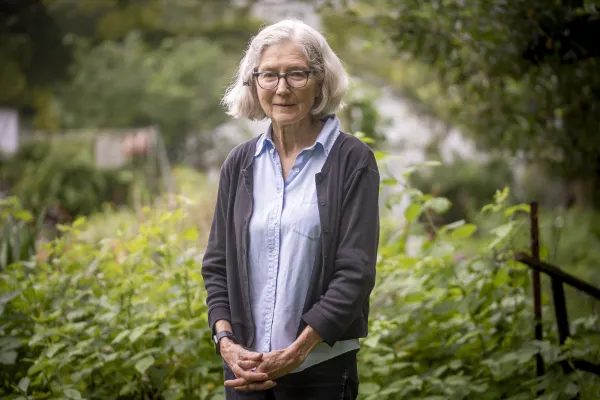
Published November 17, 2023
Beverly Duncan looks deeply at the miniscule flecks of detail oftentimes overlooked by passersby — the walking pattern of an ant; the color variations of milkweed; the kinds of natural beauty that, when observed carefully, make a small space infinite with possibility.
“Some people think I’m this great hiker and adventurist,” she says. “Really, my world is rather small, but very personal. I like telling stories of my Western Massachusetts world with plants.”

Beverly Duncan in her studio
That sort of outlook— reaching in and annotating the granular bits of one’s surroundings to tell a much bigger story—was what brought Duncan, a botanical artist from Ashfield, MA, to create two collections of small proportions: SEEDS, a series of 19 miniature books, and 52 Weeks of Observations, two clamshell-boxed sets of equally small paintings. Each collection, created with watercolor and pen-and-ink illustrations, details the life cycles of flora and fauna close to her home. The two collections took more than nine years to complete and were acquired by the Smith College Libraries Mortimer Rare Book Collection in the summer of 2023
“I’ve always loved little books,” Duncan recalls. “I was inspired by contemporary botanical painter-illustrator Lara Call Gastinger — she received a commission from some wealthy clients to visit their land and draw a plant in season every week in a journal that had been created using her watercolor paper. I was inspired to contemplate working in hand-bound books, and loved the 52 weeks of observations idea. I loved the fact that she wanted to have her watercolor paper bound into a book so that she could work on the surface that she was comfortable with.”
In the SEEDS collection, each book is small in size—5 inches square in diameter—but rich in illustrations, descriptive text, and heart. Turning the textured pages of the hand-bound books, readers can feel the love and appreciation Duncan holds for her subjects.
“In early 2015, I took a week-long book binding course in Boston, not to become a book binder, but to become acquainted with book binding,” Duncan notes. “I got some great ideas from my teacher there. She was the one who suggested clamshell boxes be made for 52 Weeks of Observation.”
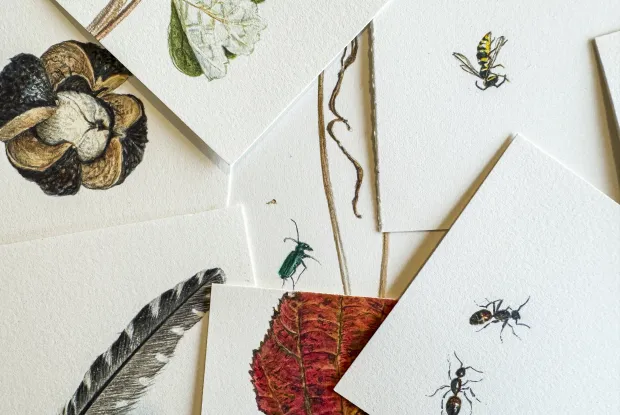
Collage of small paintings by Beverly Duncan
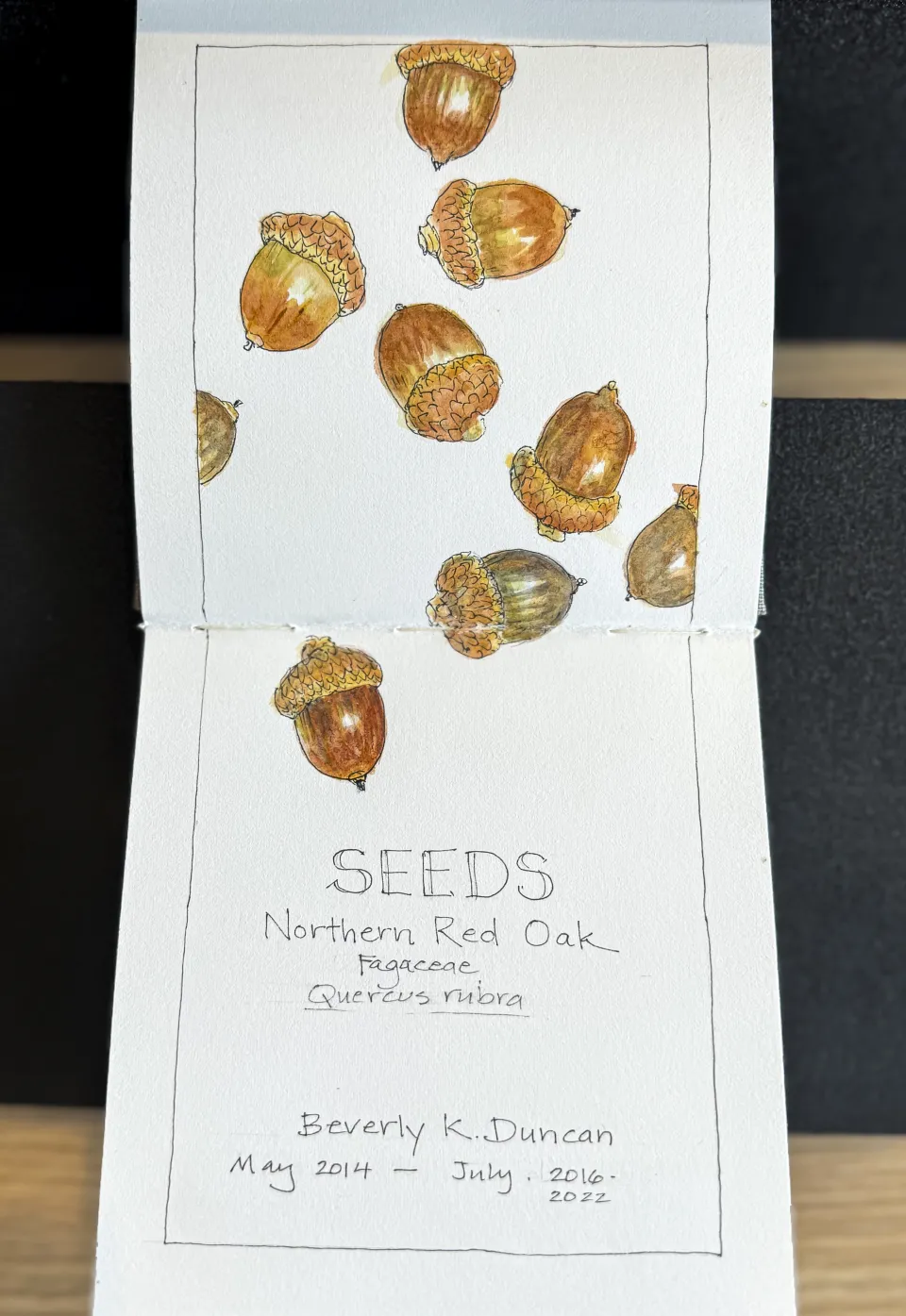
Illustration of acorns by Beverly Duncan
When deciding to embark on a multi-part book collection, Duncan also drew inspiration from botanical works from different historical moments and parts of the world, all with similar illustrations. She observed their unique styles, formats, and subjects featured on the pages, and decided she wanted to create something in the same vein. Hers, however, would be a love story told through the lens of her backyard.
“When meeting with Northampton book binder Shoshannah Wineburg of Three Bear Trap Bindery, I talked with her about the other influences for SEEDS, people of the 18th and 19th century,” Duncan says. “They were primarily European naturalists, people who had an interest in observing, sketching, and drawing what was in season. I wanted that 19th century look.”
Duncan has focused on this style of art for years; neatly displayed throughout her old farmhouse in Ashfield, walls are adorned with her signature watercolor and pen-and-ink illustrations, each depicting an isolated moment in time with nature. In her home studio, there’s dozens more on the walls and in cabinet drawers. Smaller paintings portray leaves of varying degrees of color and decay; another larger painting shows glistening, ripe blueberries; and several pieces document every possible view of an acorn. That is what inspires Duncan and keeps her invested in her tiny world — no two angles, no two acorns, are alike.
“Nothing’s boring—I think that’s a root lesson,” Duncan says. “And nothing’s easy to depict, either. SEEDS was a lot of hard work, but I also loved it and learned so much. I didn’t know how oak trees reproduce, and now I do. And I learned that acorns in the red acorn group take two years to mature. I just had fun designing every page.”
Book by book, Dunan decided how each would narrate the biography of a singular tree or shrub. Written and illustrated in real time, the books delicately showcase the tree and its surrounding botany (and sometimes woodland friends) throughout every season. For this reason, it could easily take over two years to complete one book’s content, as Duncan ensured each picture and description was as accurate as possible. Though daunting, the project gained momentum as Duncan drew inspiration and motivation from those around her.
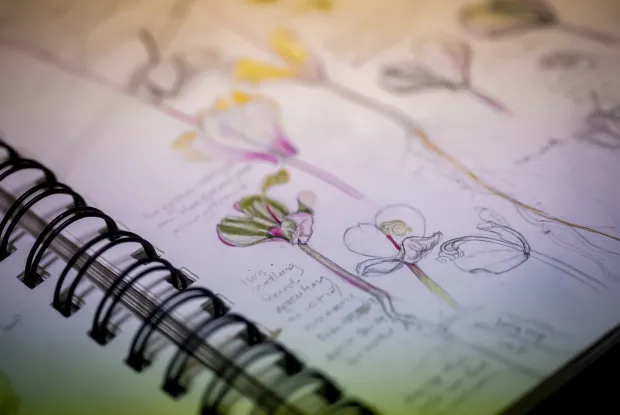
“I was hesitant to start with these precious, newly-created bound books,” Duncan recalls. “There was an exhibit at the Yale Center for British Art that included examples of natural science work over the centuries, including contemporary work by British citizens. This exhibit excited me and convinced me that I was on the right track.”
A year or so later, Duncan was able to meet the curator of the exhibit and show her early work on the SEEDS project. This meeting, Duncan says, was the push she needed to see SEEDS through completion. “The curator said, ‘if you were British, I’d be interested in acquiring this collection,’” Duncan laughs. “Her comment was the final sign to keep doing this. I needed that and ordered eighteen more books from the bookbinder.”
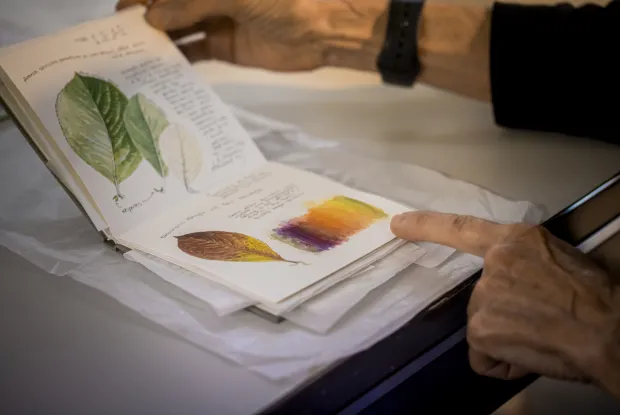
The books open vertically and invite the reader to observe each subject carefully. Duncan lets the tree’s life cycle and habit take the lead and decide how it should be depicted, and accommodates each subject’s needs with thoughtfully-painted illustrations on the page.
In the margins are even more detail, with fine-tipped pen descriptions of every leaf, stem, and seed one could expect to see when observing the featured trees. “One of the qualifications of a botanical painter is you have to be scientifically accurate,” Duncan says. “In fact, if you enter any of the big shows, national or international, there’s usually a botanist as a juror to approve of the botanical accuracy of the work.”

SEEDS is a particularly meaningful series to add to the Mortimer Rare Book Collection, as some of Duncan’s subjects are of trees rooted on Smith College campus. “I always knew Smith was a beautiful campus, and I became more specifically aware of its trees as my interest for this project developed,” she notes. “For the SEEDS project, some trees weren’t right out in my backyard and I had to go further afield.” One tree on campus, the black walnut, was a specimen always bustling with activity when she’d pay a visit for observation.
“One time, I walked over to the tree and its walnuts were falling and scattering on the ground. I picked up some and thought, ‘why are they dropping right now?’ Well, squirrels in the tree were harvesting nuts . They did not like me picking up their winter harvest. They’re not shy on the campus at all!”
Duncan says the Smith Botanic Garden provided invaluable information when documenting another campus tree, the American Elm, a tree that has been subject to disease close to her home in Ashfield. “I love the gorgeous, huge American Elm tree on Smith campus, and wanted to know how Smith kept it thriving. I contacted Landscape Curator John Berryhill, and he very politely answered my questions and sent me pictures. He explained that every three years, staff inject the roots with a fungicide that keeps the disease at bay. The information is in that tree’s book because John was willing to take the time to answer my questions and send photos of the process. I felt privileged to have those photographs.”
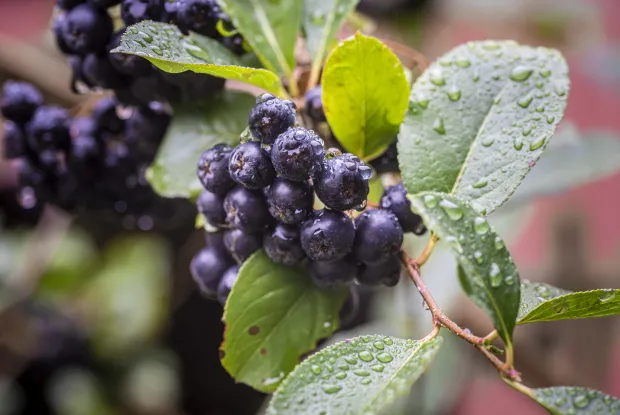
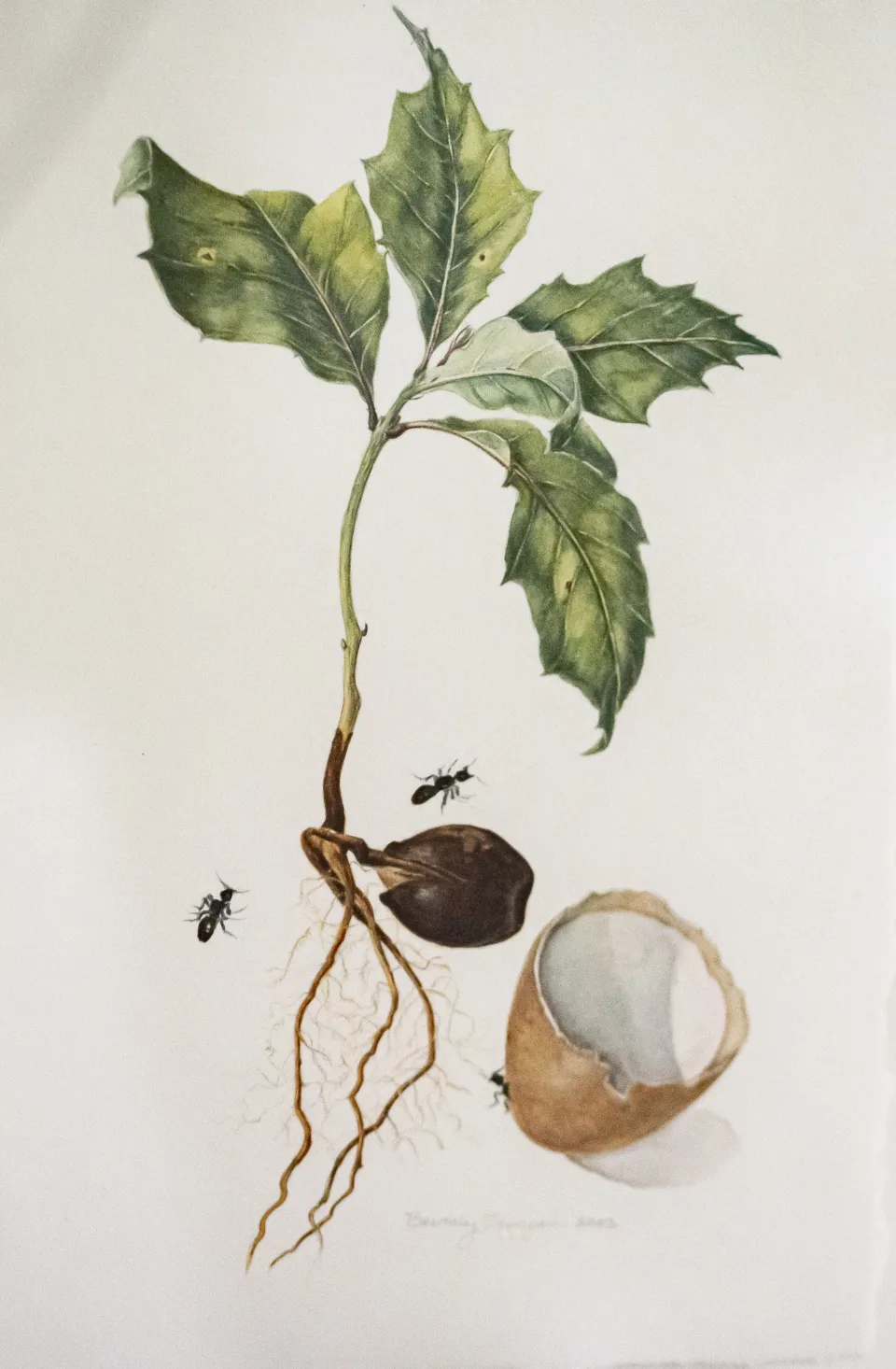
Illustration of sprout with ants by Beverly Duncan
For Smith students who may feel stymied in their studies, research, or creative pursuits, Duncan asserts that it’s okay to take the time to stop and reflect on one’s passions. “The idea of a SEEDS-type project took decades to be realized,” she says. “If you find interests over your life, pay attention to them. They have to be fun. They have to be interesting. I wasn’t encouraged to garden or pay attention to plants and the natural environment. Only as a young adult did I find this interest, and from there it evolved very slowly. I’m really glad I took the time to pull it all together.”
Reading Duncan’s books feels like a personal invitation to someone’s diary—each page is filled with the kinds of secrets and observations that are expressed only when the writer feels truly comfortable exposing their innermost thoughts. At the same time, it’s clear Duncan trusts her subjects completely and aims to tell their stories authentically. A favorite quote from Albrecht Dürer has guided her and shines through in SEEDS: “Study nature diligently. Be guided by nature, and do not depart from it, thinking that you can do better yourself. You will be misguided, for truly art is hidden in nature, and he who can draw it out, possesses it.”
To view Beverly Duncan’s SEEDS and 52 Weeks of Observations collections, contact the Smith College Libraries Mortimer Rare Book Collection.